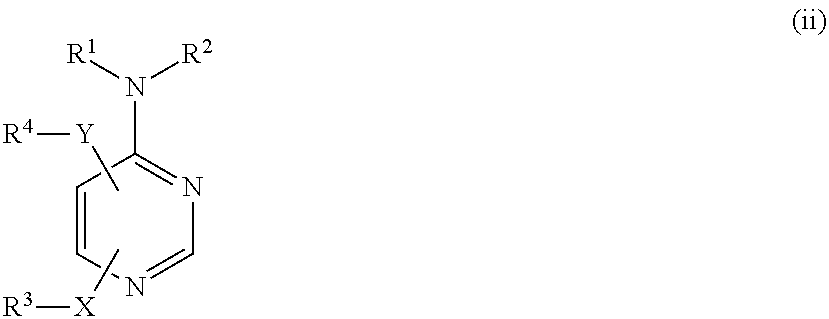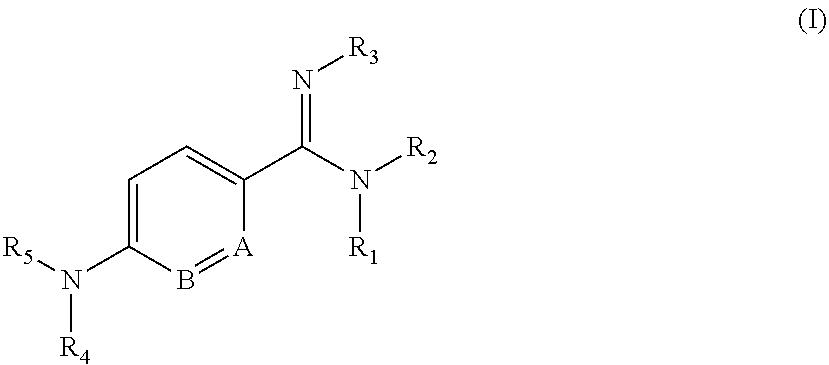Pyridyl derivatives, their preparation and use
a technology of pyridyl derivatives and derivatives, applied in the field of pyridyl derivatives, can solve the problems of poor patient prognosis, limited effectiveness of current cancer and related diseases treatment, and difficulty in clinical use with current technology,
- Summary
- Abstract
- Description
- Claims
- Application Information
AI Technical Summary
Benefits of technology
Problems solved by technology
Method used
Image
Examples
example 1
5-Amino-N-hydroxypyridin-2-carboxamidine
[0400]To a solution of potassium hydroxide (0.28 g, 4.2 mmol) in dry methanol (20 mL) was added hydroxylamine hydrochloride (0.29 g, 4.2 mmol) and the mixture was stirred for 30 minutes. White precipitate of potassium chloride obtained was filtered and to the filtrate was added 5-amino-2-cyanopyridine (0.50 g, 4.2 mmol) and the reaction mixture was stirred at reflux temperature for 6 hours. The reaction mixture was then concentrated and the crude product obtained was triturated with diethyl ether to obtain the title compound.
[0401]Yield: 0.61 g (95%); 1H NMR (DMSO-d6, 300 MHz): δ 5.54 (s, 2H), 5.58 (s, 2H), 6.87-6.91 (m, 1H), 7.48-7.50 (d, 1H), 7.84 (s, 1H), 9.40 (s, 1H); MS m / e: 153 (M+1).
example 2
Methyl 2-(5-aminopyridin-2-yl)-5,6-dihydroxypyrimidine-4-carboxylate
[0402]To a stirred solution of compound of example 1 (0.30 g, 1.97 mmol) in methanol (10 mL) was added dimethyl acetylenedicarboxylate (0.34 g, 2.36 mmol) and the reaction mixture was heated at 60° C. for 4 hours. Methanol was removed under reduced pressure and xylene (20 mL) was added to the reaction mixture and heated at 140° C. for 12 hours. The reaction mixture was then concentrated, and residue obtained was dissolved in 5% aqueous NaOH (20 mL) and was washed with ethyl acetate (2×50 mL) to remove unreacted organic impurities. Aqueous layer was then acidified with dilute 10% acetic acid, extracted with ethyl acetate (3×50 mL), dried over anhydrous sodium sulfate and concentrated to obtain the title compound.
[0403]Yield: 0.025 g (5%); 1H NMR (DMSO-d6, 300 MHz): δ 3.83 (s, 3H), 5.96 (s, 2H), 6.99-7.01 (m, 1H), 7.84-7.87 (d, 1H), 7.94 (s, 1H), 11.95 (s, 2H); MS m / e: 261 (M−1).
example 3
2-Chloro-N-(6-cyanopyridin-3-yl)acetamide
[0404]Triethylamine (0.50 g, 4.9 mmol) and chloroacetyl chloride (0.56 g, 4.9 mmol) were added dropwise at 0° C. to a stirred suspension of 5-Amino-2-cyanopyridine (0.27 g, 2.25 mmol) in chloroform (10 mL). The mixture was stirred at room temperature for 12 hours. The reaction mixture was diluted with chloroform (50 mL) and washed with water (2×50 mL). The organic layer was dried over anhydrous sodium sulfate, concentrated and the crude product obtained was crystallized from chloroform:petroleum ether (1:2) to obtain the title compound.
[0405]Yield: 0.42 g (95%); 1H NMR (DMSO-d6, 300 MHz): δ 4.35 (s, 2H), 7.99-8.01 (d, 1H), 8.24-8.26 (m, 1H), 8.40 (s, 1H), 10.98 (s, 1H); MS m / e: 195.96 (M+1).
PUM
 Login to View More
Login to View More Abstract
Description
Claims
Application Information
 Login to View More
Login to View More - R&D
- Intellectual Property
- Life Sciences
- Materials
- Tech Scout
- Unparalleled Data Quality
- Higher Quality Content
- 60% Fewer Hallucinations
Browse by: Latest US Patents, China's latest patents, Technical Efficacy Thesaurus, Application Domain, Technology Topic, Popular Technical Reports.
© 2025 PatSnap. All rights reserved.Legal|Privacy policy|Modern Slavery Act Transparency Statement|Sitemap|About US| Contact US: help@patsnap.com



